GRC Tool: Governance, Risk, and Compliance Simplified
Discover how modern GRC tools support organisations to enhance risk management, improve cybersecurity, and ensure compliance with regulations, policies and procedures.
Manage risk
Build a risk register, carry out risk assessments, monitor risk levels, set controls, and implement remediating actions in one centralised platform.
Enhance cybersecurity
Efficiently manage cyber risk and set effective controls. Manage & resolve cyber incidents and implement robust business continuity plans.
Achieve compliance
Build an ‘obligations register’ to easily monitor compliance with industry and government regulations, policies, and procedures.
How do (Governance, Risk and Compliance) GRC tools work?
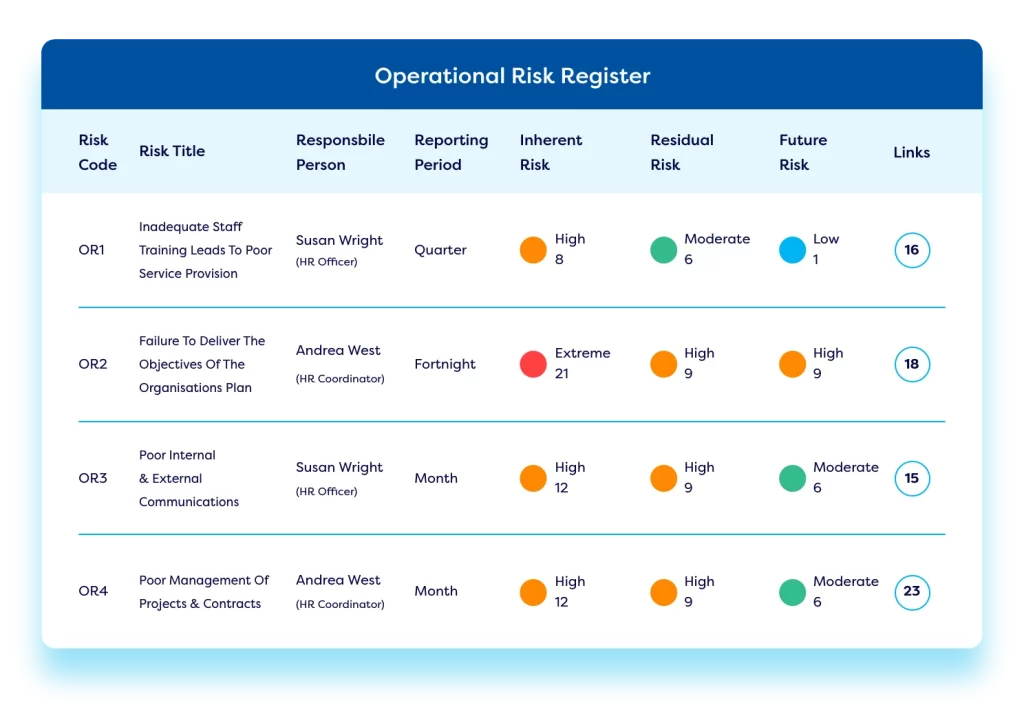
Establish a risk register
Firms can use the platform to design a best-practice risk management program. Firms can implement an online risk register within our GRC tool to categorize and rate each risk based on its impact and likelihood. The Camms enterprise GRC tool offers numerous advantages over other vendors, allowing teams to create unlimited risk registers with thousands of risk types and categories.
Create a risk appetite & monitor risk levels
Our GRC tool allows firms to establish Key Risk Indicators (KRIs) and define their risk appetite, ensuring that risk levels stay within the desired parameters – ensuring a robust risk management strategy.


Establish robust controls
Our GRC tool makes control management easy. Our platform provides a structured approach for managing potential risks and setting internal controls in alignment with widely recognized regulations such as COSO, ISO 31000, and SOX. Our tool enables firms to map risks to the corresponding controls, offering insights into potential risk exposure and supporting the implementation of effective risk mitigation strategies.
Establish risk treatment plans
Our GRC tool provides a framework supported by automated workflows to develop comprehensive risk treatment plans. Step-by-step processes alert risk owners and initiate workflows, allowing companies to understand, respond to, and mitigate risks effectively.
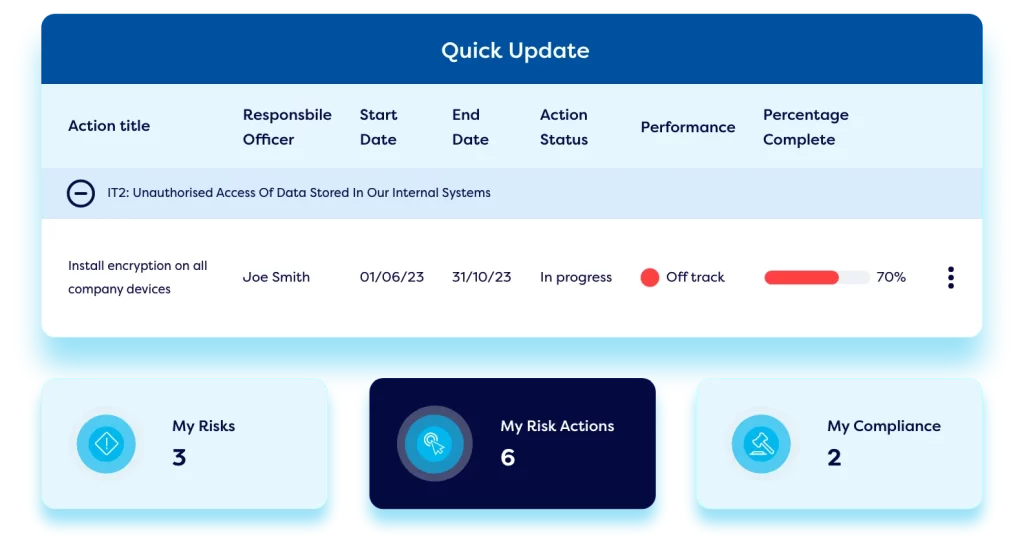

Understand organisational risk status
Our GRC tool offers a comprehensive view of your inherent risks through a series of reports and dashboard visualizations – which are customisable to meet the needs of each user profile thanks to a preset permissions hierarchy. Lower-level employees can utilise our platform to complete risk assessments and control checks using online forms, while executives and leadership teams can access detailed dashboards & reports on risk levels and exposure, delivering in-depth risk intelligence.
IT & cybersecurity GRC
Use the Camms IT GRC tool capabilities to effectively manage cyber risk by establishing a cyber risk register, performing online cyber risk assessments, and implementing effective controls & mitigating actions. Manage and resolve cyber incidents with online reporting and automated workflows and implement an asset management register to understand aging equipment and licences. Access best-practice frameworks to ensure compliance with data privacy regulations like GDPR, ISO 27001, NIST, HIPPA, CPS 234 and many more. The cybersecurity capabilities within the Camms GRC tool ensure your firm can manage & mitigate cyber security risk with confidence.
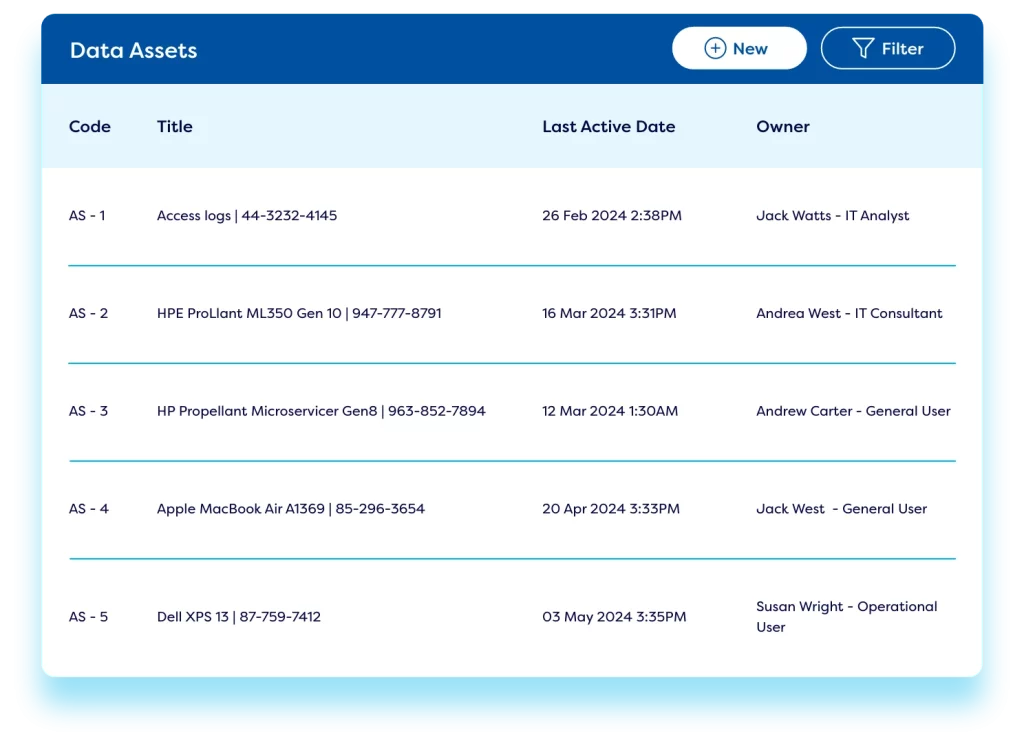

Third party risk management
Develop an optimal third-party risk management process for third-party vendors & service providers. Establish an online vendor library and implement digital risk assessments with conditional workflows and clear scoring methodologies for result analysis. Automate the monitoring of critical metrics such as SLAs, KPIs, and industry benchmarks to ensure ongoing vendor performance oversight. Access third-party risk intelligence providers to get deep insights into your vendor network. Effortlessly compare vendors, standardize onboarding and offboarding procedures, and manage contract renewals for third parties from a centralised GRC tool.
Incident management
The Camms GRC tool features best-practice incident reporting functionality that allows for quick capture, escalation, and resolution of incidents. Staff can easily report incidents via online forms or a mobile app with all data feeding into the platform. Automated workflows escalate incidents to the relevant stakeholders so they can be worked through to resolution. Controls can be easily implemented to minimise incident levels, and risks can be linked to related incidents to identify root causes. Firms can easily view reports & dashboards to understand inherent causes of incidents – enabling them to implement preventative measures to reduce reoccurrence.


Audit management
Utilize the Camms’ GRC tool to efficiently schedule and manage your internal & external audits. Automated workflows distribute online audit forms to stakeholders, enabling them to conduct audits and capture & report on findings. Automated workflows fully document and automate the remediation process.
Manage compliance with regulations, policies, and procedures
Use the Camms GRC tool to establish a best-practice compliance program to keep track of your compliance requirements and manage compliance risk. Teams can create an ‘obligations register’ for relevant internal policies, procedures, and regulations, and easily monitor compliance. Firms can use the GRC tool to implement a best-practice regulatory change process to streamline compliance efforts. The platform can integrate with your preferred regulatory content provider for real time regulatory updates that feed directly into your regulatory change management process ensuring the relevant processes and policies are updated in line with the requirements. Firms can also use the GRC tool for policy management by developing a library of current policies and managing changes, approvals, and employee attestations.

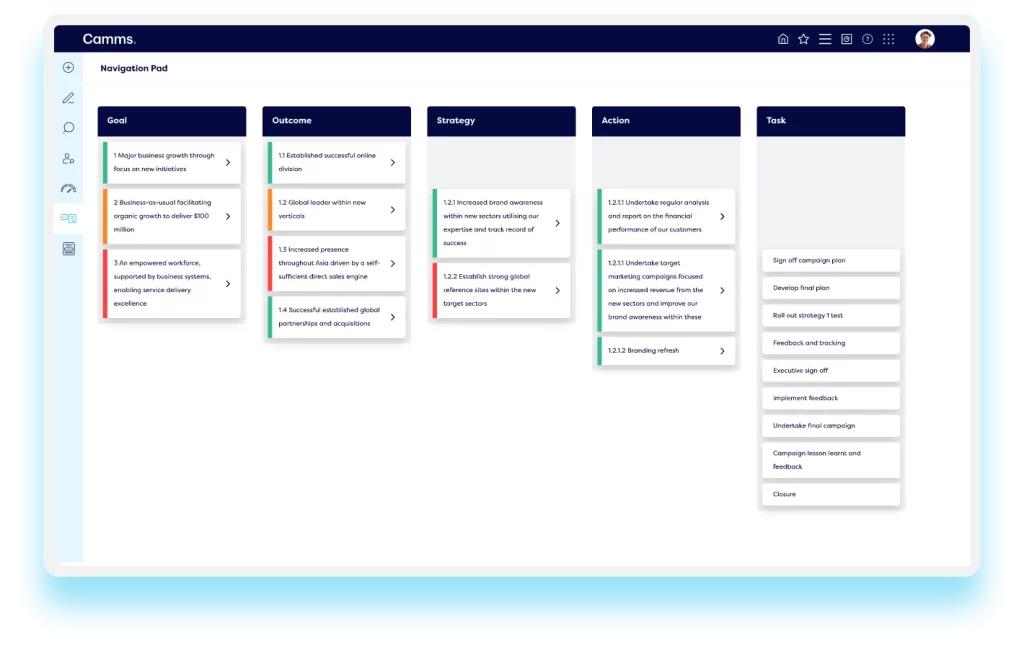
Strategic planning
The Camms GRC tool offers strategic planning capabilities. This enables firms to map out their strategic goals and break them down into programs, tasks, projects, and actions that can be allocated to relevant stakeholders across the business for completion. Firms can easily manage the associated timelines, budgets, and resources to ensure successful strategy implementation. As tasks and actions are completed, progress is indicated at each level of the strategy – enabling leaders to understand strategic progression, address problems, and effectively manage any strategic risks that could derail their strategy.
Why Choose Camms' GRC Solution?
Align Risk & Compliance to Business Objectives
Choose a GRC tool that offers integrated GRC software, enabling your team to align risk with organisational objectives and business processes. This empowers your organisation to take calculated risks to achieve objectives without exceeding your risk appetite.
Data Security & Privacy
The Camms GRC platform is highly secure and certified to esteemed information security standards including SOC Type 1&2, ISO 27001, and Cyber Essentials. Our platform features a complex permissions hierarchy, encryption, and audit trails to ensure data privacy and compliance with IT security standards.
Discover more about Camms'
GRC Tool
Resources relating to GRC Tools
The latest and most relevant pieces of governance, risk, compliance and IT GRC content to keep you up-to-date.

A Simple Guide to Choosing the Right Risk Management Software
Deploying the right Risk Management software, means your organisation is equipped to take the right actions faster but what are the standout qualities of an effective risk management software solution? Find out in this eBook.
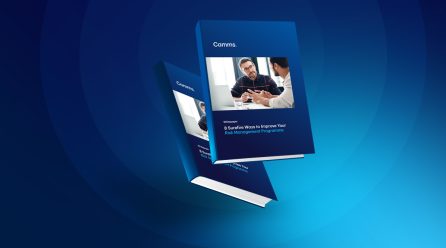
8 Surefire Ways to Improve Your Risk Management Program
This whitepaper highlights the importance of adequate risk reporting to guide decision-making, identify risk exposure, and uncover control inefficiencies and explains how to get a complete view of risk across your organisation.
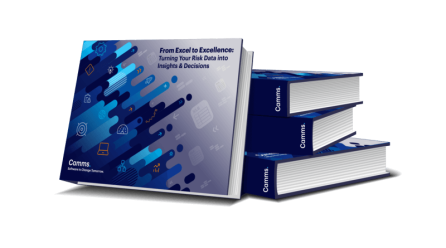
From Excel to Excellence: Turning Your Risk Data into Insights & Decisions
In this eBook, we explore why spreadsheets are outdated for risk management and help you to identify if your business is ready to swap spreadsheets for an automated GRC solution. Plus, we detail the top 10 reasons to switch from spreadsheets to software.
Frequently asked questions about
GRC Tools
A GRC tool is an online software platform that helps firms implement structured governance, risk, and compliance processes in line with industry best practices – enhancing risk management. Companies can create online risk and control registers, conduct risk assessments, and establish workflows to mitigate risks in high-risk areas. These platforms also support regulatory compliance, audit management, incident management, and alignment of risk with enterprise performance and strategic goals. Typically, they offer various dashboards and reporting options – providing teams with GRC analytics for a comprehensive view of risk and compliance to identify and address problem areas effectively. The automation enables firms to cut back on GRC resources, saving valuable time and money.
GRC stands for Governance, Risk and Compliance and the term is used collectively to describe the processes an organisation uses to manage risk, ensure compliance with regulations, policies, and procedures, and ensure sufficient governance practices within the organisation. GRC tools are software platforms that help firms to structure best practice risk & compliance processes that align with the guidance provided in the OCEG GRC capability model.
When choosing an enterprise GRC tool for risk management, companies must consider which staff and teams will be using the tool and the metrics they will need to report on. To enhance your GRC program, take into account the following considerations when selecting a GRC tool:
- The GRC regulations you must comply with and how they will influence the structure of your GRC framework within the GRC tool.
- The method you will use for categorizing and rating risks to establish a unified rating system across the enterprise.
- Whether the GRC tool can be customised to meet the unique, specific requirements of your organisation.
- Consider if the GRC management software can scale with your organisations risk management and regulatory compliance needs, offering additional functionality as your requirements expand and your GRC process
- Check out the data privacy and security features provided by the GRC tool, and the additional security options available.
- Investigate whether the GRC tool offers integration capabilities to integrate with your other systems and platforms via APIs to maintain a single source of truth for risk and compliance data and enable real-time risk monitoring based on live company transactional statistics.
- Consider the users of the GRC platform, the type and format of data they will input, and the reports and metrics they need to generate, including their format and frequency.
- Consider the pricing model of the GRC tool – look for platforms that offer a flexible subscription model based on user numbers and number of modules implemented to ensure you only pay for what you need.
- Look for GRC tools for assurance leaders that provide a wealth of reporting outputs relating to your GRC activities for leadership teams and regulating bodies.
- Consider the GRC model you would like to adopt and make sure the platform can align with your internal risk and compliance needs.
- Ensure that the risk management solution within the GRC tool aligns with ISO 31000 best practice risk management processes.
The realized benefits of using a GRC tool include:
- Modern GRC tools are highly customisable – making it simple to tailor the platform to your bespoke needs and preferred terminology.
- Reduced time spent on risk reporting, data manipulation, and administrative tasks due to GRC automation and workflows.
- GRC software and tools for risk and compliance management offer a centralised view of risk and compliance activities across a company’s global operations – improving the overall GRC strategy of an organisation.
- GRC tools ensure easier GRC management and improve an organisations GRC approach by enabling the entire organisation to participate in risk management activities as part of their daily roles – generating extensive risk data to support enterprise decision-making.
- IT GRC tools provide better visibility into an organisation’s IT risk profile and help manage cyber risk & vulnerabilities.
- GRC tools lower the costs associated with risk monitoring and reporting due to automation.
- GRC tools help to lower and reduce risk, by enabling firms to set up an active control library to reduce the likelihood of risk – regular checks and testing can also be carried out within the platform to ensure control effectiveness.
- GRC tools help with risk assessments by enabling staff to carry out online risk assessments – with results feeding directly into the platform.
- GRC tools enhance an organisation’s enterprise risk management approach by facilitating crucial links between risk management, strategic planning, and operational performance – ensuring effective Integrated Risk Management (IRM) processes.
- GRC tools help firms build a GRC dashboard, offering detailed insights on how the firm can adjust operations to reduce risk, achieve strategic objectives, and ensure governance and compliance.
- GRC compliance tools enable firms to structure their processes in line with industry & government regulations to ensure regulatory compliance.
- Many GRC tools also offer strategic planning capabilities – enabling firms to manage risk in line with strategic objectives in order to achieve their business goals.
- Improved cybersecurity – GRC cyber tools ensure the organisation can effectively manage and resolve cyber risks and incidents.
Here is a run down of some of the functionality and key features firms should look for when selecting a top GRC tool.
- Opt for a GRC tool that can be configured by your own users to significantly reduce costly implementation and professional services fees.
- Choose a GRC management tool with unlimited risk registers, types, and categories to enable comprehensive risk reporting across specific areas and the entire enterprise.
- Select GRC tooling solutions with multiple customisable reporting outputs to meet your specific operational needs.
- Opt for a GRC tool that integrates with your existing systems and data sources to ensure a single source of truth for all your risk and compliance data.
- Look for reliable GRC tools that offer numerous top features, including best-practice use cases for compliance, governance, incident reporting, project management, and ESG – allowing you to manage these functions in one platform and integrate the data for better reporting.
- Choose GRC compliance tools that provide out-of-the-box templates and forms to meet regulatory requirements such as GDPR, ISO 31000, COSO, and NIST to ensure regulatory compliance – formulating compliance programs that align with industry best-practices.
- A GRC tools cybersecurity capabilities should include, IT and cyber risk management, IT incident management, business continuity, data privacy compliance and business continuity planning – preferably in one platform so these functions can be integrated.
- Look for a GRC system that works for multiple industries with live demonstrable use cases in your sector. Key industries that benefit from GRC tools include highly regulated industries like, healthcare, financial services, gambling & gaming and high-risk industries like, retail, transportation, logistics, oil, gas, energy, water and manufacturing.
- Risk management and compliance suffer as teams are relying on substandard risk and compliance data due to a lack of data governance rules results in data entry errors and incomplete information.
- Capturing risk and compliance data in various forms & spreadsheets leads to problems such as copy-and-paste errors, overwritten data, and incomplete fields.
- Disparate enterprise GRC data stored in disconnected spreadsheets creates substandard risk data and an ambiguous risk framework, generating misleading reporting outputs that lead to poor decision-making.
- Relying on manual processes without automation slows down the resolution of risk events, allowing risks to escalate to intolerable levels.
- Siloed processes and dispersed data sources make it difficult to link risks to the relevant controls, policies, and procedures to understand their correlations.
- Large firms struggle to compare risks across different buildings due to multiple risk frameworks and siloed data, making it challenging to make risk-based decisions across departments and sites.
- Data migration – importing your existing GRC data into a new GRC tool can be a challenge if the existing data quality is low – try cleaning up your data before import to ensure only high-quality accurate data with completed fields in the correct format is imported.
- Cultural resilience – Implementing a GRC tool can be a huge change for an organisation and its stakeholders and staff. Be sure to engage stakeholders early in the process to get them on board and ensure the tool will work in a way that benefits them with minimum impact to their daily role.
- User adoption – Training is key to ensure the GRC platform is adopted and widely used – this will ensure users are entering accurate information – providing top quality risk data to support data-driven decision-making.
- Security & privacy concerns – Bring your IT team into the procurement process to ensure they are on board and look for GRC tools that are certified to ISO 27001, SOC Type 1 & 2, and Cyber Essentials– providing adequate security assurance. Ensure the platform offers sufficient access controls and user permissions settings to restrict access to data when needed.
- Integration with other systems & data sources – GRC solutions often need to integrate with your other systems & data sources to pull vital data into the platform to monitor risk levels in real time. Look for tools with ‘API libraries’ that have experience integrating with multiple systems to ensure the platform you select will integrate with your current and future systems.
- Cost – A GRC tool will likely cost more than using manual processes like spreadsheets and email so be sure to demonstrate how the platform will generate cost savings & efficiencies upon implementation in your business case.
Get started and request a free demo of our GRC tool
Fill out our simple form to see the Camms’ GRC tool in action.
